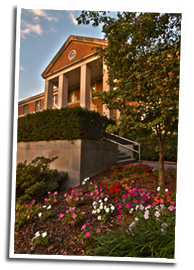Milligan’s P.H. Welshimer Memorial Library celebrates 50th anniversary
MILLIGAN COLLEGE, Tenn. (Oct. 7, 2011)—This year marks the 50th anniversary of Milligan College’s P.H. Welshimer Memorial Library, a building that has served as a center of learning and study to generations of students.
To celebrate the occasion, the library will host a reception for all current and former library staff and student workers on Saturday, Oct. 29, from 1-2 p.m. in the library. The event is part of Milligan’s annual Homecoming festivities, Oct. 28-29.
In addition to the anniversary reception, the library will host its fourth annual Homecoming Book Sale on Oct. 27 and 29, from 9 a.m. to 5 p.m. and Oct. 28, from 9 a.m. to 1 p.m.
The public is welcome to browse nearly 5,000 items including books, media, Milligan yearbooks and more. Everything is $2 and all proceeds benefit the Million Pennies Campaign for library renovation.
“We hope these events will be a time when people will come together with colleagues from decades past, swap stories, reminisce and make new memories,” said Gary F. Daught, Milligan’s director of library services since 2007.
A center of learning
The library facility, which opened in 1961, is a three-story brick building containing approximately 24,000 total square feet. About 16,150 square feet of space, or 68 percent, of the building, is available user space, in the form of stacks, study rooms and open areas.
The library was named in memory of P.H. Welshimer, a Restoration Movement leader and the long-time minister of First Christian Church of Canton, Ohio. Construction of the library was funded by a gift of the T. W. Phillips Jr. Charitable Trust and the Phillips family of Butler, Penn., after an initial gift by the Kresge Foundation of Detroit, Mich.
Before the P.H. Welshimer Memorial Library opened, Milligan’s library was housed in four cramped rooms in the Administration Building, now called Derthick Hall. On moving day, Milligan students quickly and efficiently carried 25,000 to 30,000 books and materials across campus, row by row, to the new building. Thanks to a book brigade, the entire move took just three or four hours at no expense to the college.
A well-built brick structure with beautiful stone and marble accents, the library has served Milligan well throughout the years. It also has changed and adapted to meet the 21st century needs of the students and faculty.
“So much has changed over the last 50 years in the way students and faculty utilize the library and its resources,” Daught said. “The most dramatic changes are clearly related to the advent of personal computer technology, and the growth of electronically accessed information resources.”
User-friendly features
In 1961, students had to come to the library because that was the only place where physical information resources could be accessed. The last 10 years have brought tremendous changes to the library, transitioning from what Daught describes as a “library-centric” frame of mind to a “user-centric” atmosphere.
Some of the most significant changes that have created a more user-centric atmosphere include the expansion of the library’s online collections and the reconfiguring of more than 1,600 square feet of prime space on the main library floor from library worker space to user space.
In April 2011, the library redesigned its website (http://library.milligan.edu) and integrated social media (Facebook, Twitter and an active library blog) within the site to better promote the library to the Milligan community. In September, the library launched a comprehensive library resources search engine called MCSearch.
“MCSearch brings the convenience of a Google-like search experience that our students know and appreciate to the library’s high-quality information resources,” Daught said.
The library also houses an extensive archive of thousands of photos, publications and documents. The digital collection includes a complete run of Milligan’s Buffaloannual, along with registers, bulletins and catalogs from 1880 to 2008. Milligan’s student newspaper, the Stampede (including issues from 1940 to 2005) is also digitized. The images are full-text searchable and easy to navigate. The digital collection is freely available for viewing or download in a variety of formats atwww.archive.org/details/milligancollegearchives.
The next chapter
Despite the increasing online collections and tools, a record number of students use the library building. In 2007, the library began tracking the number of people inside the building each hour the library was open. Over the past four years, the library has seen a 400 percent increase in the number of students who use the building each hour.
“Increasing access to information resources online has not undermined physical use of the library,” Daught said. “Students have responded favorably to our efforts to become more intentionally user-centric. We have recovered the status of the library as a hub of academic activity on campus through active engagement with our users, a vigorous program of information literacy instruction and rethinking library space for student learning.”
While Daught isn’t sure what changes are in store for the library during its next 50 years, he is confident the library will continue its “attitude of full engagement and continual improvement” to meet the needs of users of the generations to come.


